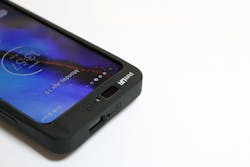The company that is widely regarded as the pioneer of LED-based Li-Fi has told LEDs Magazine that “laser light will better serve Li-Fi,” and has taken its first step in that direction by developing a laser-based “Light Antenna Module” for embedding into consumer devices such as phones.
Edinburgh-based pureLiFi, co-founded by Li-Fi inventor Harald Haas nearly a decade ago, has generally led the pack in developing the Wi-Fi-like method for transmitting data and the Internet. Li-Fi uses modulated light waves rather than the radio waves of Wi-Fi. Its proponents have long extolled it as more secure than Wi-Fi, for causing no electromagnetic interference, and as a way to relieve the crowded Wi-Fi spectrum, among other benefits. Some have maintained it offers superior speeds, although real world conditions can intervene.
But Li-Fi has yet to gain widespread adoption, in large measure because computer and phone makers have by and large not embedded Li-Fi chips the way they have with Wi-Fi, leaving Li-Fi users to plug in inconvenient USB sticks, or “dongles,” that contain the necessary electronics. The absence of an industry standard has also held back progress.
During the slow gestation, interest has quietly grown in moving the technology on from LEDs and toward the use of laser chips, which can be modulated about 100 times faster and which, likewise, can emit light traveling about 100 times farther. Such a move might then help Li-Fi genuinely claim the “faster” crown in comparison to Wi-Fi.
The move to laser chips could well become the industry’s “jet engine” moment, replacing the propellers of LEDs.
“New technologies such as laser light…will better serve Li-Fi component and system companies to ensure that breakthrough innovations in the lighting devices industry are readily linked to Li-Fi so that lighting and Li-Fi become inseparable from the start,” a pureLiFi spokesperson told LEDs after our recent story ran in which we pointed out that co-founder Haas had surfaced as an advisor to laser stalwart Kyocera SLD, which is helping to develop a laser Li-Fi system for the aviation industry. Haas is also pureLiFi’s chief scientific officer.
We had asked the company before the story whether pureLiFi itself was embracing a switch to lasers.
The spokesperson responded after publication that the Light Antenna Module that it released earlier this year — around April — actually uses an infrared laser chip. The module is designed to be small enough to reside inside smartphones and is available to device makers. PureLiFi is also positioning its laser components for use inside the access points (often luminaires) that send and receive data to and from those devices, the spokesperson told LEDs.
The case for laser
In April, pureLiFi posted a video on its website showing two Moto G smartphones swapping video files with each other via Li-Fi. The retrofitted phones do not use embedded Li-Fi chips. Rather, pureLiFi surrounded the phones in cases that were equipped with the laser Li-Fi circuits. The circuitry connects straight into the phones without using a USB port, she noted.
We had also wondered in our recent article whether Haas’ emergence as an advisor to Kyocera SLD indicated any move away from pureLiFi.
“Professor Haas remains a committed co-founder and chief scientific officer of pureLiFi and we are supportive of the work he’s doing to advance and improve the Li-Fi ecosystem,” she said. The “ecosystem” improvements include a migration toward laser technology.
Since co-founding pureLiFi in 2012 (then called pureVLC), Haas has straddled the worlds of industry and academia. Besides serving in his role at pureLiFi, he is also a professor and mobile communications chair at the University of Edinburgh.
The pureLiFi spokesperson pointed out that Haas is actively engaged in leading the LiFi Research and Development Center (LRDC), an academic/industry group based at the University of Strathclyde in Glasgow. That group has published research showing laser Li-Fi’s faster speeds.
Two years ago, Haas told this writer that, compared to LEDs, lasers “can go an order of magnitude faster.” At the time, pureLiFi LED systems were operating experimentally at about 1 Gbit/s (slower in the real world), but Haas enthused that, with lasers, “I see a clear path to 100 Gbit/s in the next year or two, and we are looking at 1 Tbit/s in the next five years.”
In his academic capacity, Haas has also been part of a five-year, multi-university project called the Terabit Bidirectional Multi User Optical Wireless System for 6G (TOWS), which with £8 million in UK government funding was hoping to hit 1 Tbit/s by 2024. Leeds University was leading TOWS, which also included the University of Cambridge.
In the same spirit of collaboration, pureLiFi is also a founding member of the Light Communications Alliance, where the spokesperson noted the company works with a number of other companies to advance Li-Fi. Those companies span the Li-Fi ecosystem, including mobile network operators and device makers, as well as companies that could be considered pureLiFi competitors, such as Signify as well as the French Li-Fi company Oledcomm.
In his role as professor, Haas is also part of a team from different institutions examining a technique called RIS that could lessen the need for Li-Fi to have direct line of sight and thus expand the technology’s physical distance reach.
Happy together?
For all the togetherness, the industry has struggled to agree on a standard technology. When we last looked into this, Signify was preferring a protocol backed by the International Telecommunications Union (ITU) while pureLiFi was leading a committee at the Institute of Electrical and Electronics Engineers (IEEE) to establish a different protocol. The IEEE standard effort has been long running. It is “due for full ratification soon,” the pureLiFi spokesperson said.
It’s possible that the shift to laser technology might galvanize things. Laser Li-Fi development itself faces hurdles. For example, while lasers can modulate faster than LEDs, engineers must figure out how to harness that capability in a reliable manner. Laser Li-Fi in its early days has been less energy efficient than the LED approach. Infrared lasers could help mitigate that, which is possibly why pureLiFi chose infrared for its Light Antenna Module.
Via Haas’ advisory work with Kyocera SLD, both pureLiFi and Kyocera SLD could end up improving the state of laser Li-Fi systems.
LEDs expects pureLiFi to soon announce more about its future plans, technologies, and partnerships.
MARK HALPER is a contributing editor for LEDs Magazine, and an energy, technology, and business journalist ([email protected]).
For up-to-the-minute LED and SSL updates, why not follow us on Twitter? You’ll find curated content and commentary, as well as information on industry events, webcasts, and surveys on our LinkedIn Company Page and our Facebook page.





